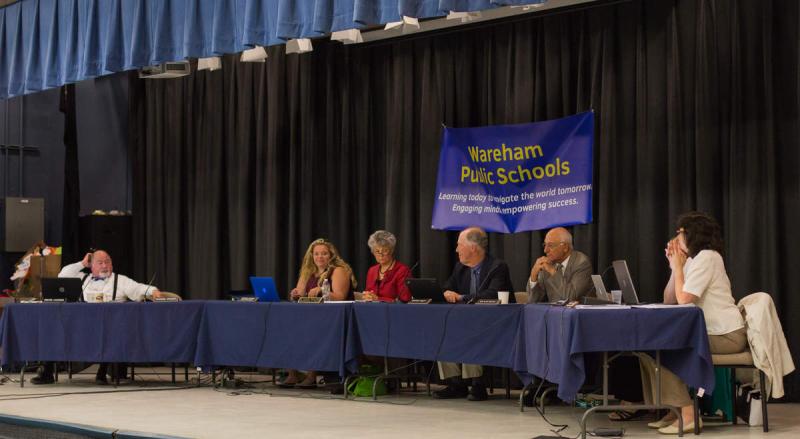School Choice hurts Wareham
One hundred and five students graduated from Wareham High School this month, the smallest graduating class at the high school in decades. Students are leaving in droves to attend vocational schools, private and charter schools and even public schools in surrounding districts.
It is the latter option, students leaving through the School Choice program, that is most vexing for school officials. It is a problem that cost the schools nearly $1 million in state aid reductions this year, as 155 Wareham residents chose to get an education at another public school.
It is a problem that cripples budgets, impacts services and lowers property values. And it’s only continuing to grow.
School officials have struggled to figure out why parents are sending students elsewhere, and how to fix the problems and perceptions of the Wareham school district.
The School Choice program was enacted in Massachusetts in 1991. It allows parents to send their kids to public schools outside of their home district so long as the kids are accepted into a limited number of slots in “receiving districts.”
The sending district pays for the child’s tuition in his or her new school district via a reduction in Chapter 70 state aid funds that are given to the receiving district.
Districts can opt out of receiving students through the School Choice program, but they cannot opt out of allowing parents to send their children out of district. Transportation must be provided by the parents of the School Choice children.
In 2015, School Choice cost Wareham $919,000 in state aid reductions and the problem only seems to be getting worse. From 2006 to 2011, Wareham was a net receiver of students, making it a slight revenue producer for the district. In 2011 the district received received 47 students and sent out 31. In 2012 the numbers switched for the first time as the district received 33 students and sent out 43. It then began to skyrocket. This past year, Wareham received 25 and sent out 155 students.
“Perhaps we haven’t done a good job of selling ourselves,” said Wareham Superintendent Kimberly Shaver-Hood. She said that in questionnaires sent to parents, the main concerns are academics and a perceived lack of safety.
“Part of our mission is to change the perception. Once it’s in place, it’s hard to change,” she said.
Wareham is a level one High School, putting it in the highest-performing group in the state school classification system. Level One means the school is meeting its improvement goals on the MCAS. Old Rochester Regional is a level two high school.
Wareham, however, does not fare so well in rankings that consider factors beyond MCAS improvement.
In Boston Magazine's 2014 rankings of high schools in greater Boston, Wareham ranked 123 of 173 schools, falling between Waltham High School and Revere High School. ORR wasn’t included in the survey.
Niche.com, a website that ranks schools nationwide, puts Wareham High 228th in Massachusetts and ORR 88th.
Liz Strawn’s son Noah just finished his sophomore year at ORR. After he finished attending a junior prep school he wanted to come home for high school. Strawn, a Wareham resident, said she applied to ORR because of a perceived improvement in academics and safety.
“I had heard really great things academically about ORR and thought that might be really great for Noah, where he needs help academically,” Strawn said.
She sent him to prep school in the first place because of one instance at Wareham Middle School in seventh grade when Noah received a 5 out of 100 on a math test, but she never heard from his teacher. She said teachers at ORR went out of their way to reach out to her when Noah was struggling at get him the help he needed.
“He was having trouble in two classes, and both of those teachers stayed after on a day they wouldn’t normally stay after,” she said.
Tina Galavotti of Wareham has a son Nicholas, who also just finished his sophomore year at ORR.
“A lot of the classes he was in, the people were so chatty, you couldn’t get your work done. At ORR that’s not the case. I wanted him to be challenged more academic-wise.”
“You hear some stories, where there are just some really great kids in Wareham, but I think you want to take your child and shelter him from any kind of situation that would harm them or influence them,” Strawn said. “I am sure there are bad kids at ORR, too, but there are probably less and less is more in this circumstance.”
Wareham School Committee member Mel Lazarus disagrees with this assessment.
“The safety record, discipline record, is as good if not better than any of the other schools parents are sending kids out to,” he said. Lazarus has first hand knowledge of the discipline situation in Wareham, having recently retired after nearly two decades as a teacher and administrator at the high school. He agrees with Shaver-Hood that the problem is a misconception of the quality of the schools.
“If people took the time to get to know the school system - they’d realize they’re missing out on a lot of good things,” Lazarus said.
Shaver-Hood highlighted Wareham's two dual enrollment programs, the one for eighth-graders to attend high school classes and the one allowing seniors to take classes at Bridgewater State University. She also praised the STEAM Academy, where roughly 80 seventh-graders learn about science, technology and engineering, arts and humanities, and mathematics from different perspectives in an environment outside the classroom, such as with the creation and maintenance of the Middle School cranberry bog.
Despite being a major fiscal problem, there doesn’t seem to be an immediate fix to turn the tide.
Lazarus said that teachers in years 1-5 of their career at Wareham are the lowest paid in the South Coast Conference, and he sees that as something that needs to change.
Shaver-Hood said technology improvements are continuously being made at the schools, from interactive projectors at Decas and boosted wireless capacities at Minot, to incoming Chromebooks for middle school students.
“We’re not putting our heads in the sand,” Shaver-Hood said. “How do we improve what we’re doing and transmit that to parents?”
















